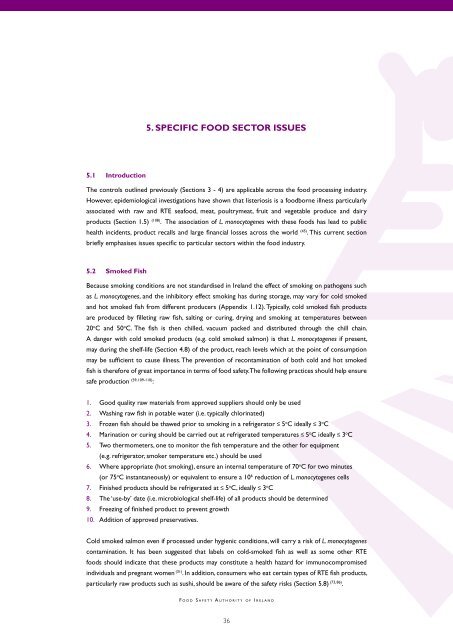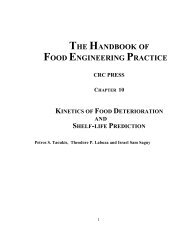Download - SMAS
Download - SMAS
Download - SMAS
- No tags were found...
Create successful ePaper yourself
Turn your PDF publications into a flip-book with our unique Google optimized e-Paper software.
5. SPECIFIC FOOD SECTOR ISSUES5.1 IntroductionThe controls outlined previously (Sections 3 - 4) are applicable across the food processing industry.However, epidemiological investigations have shown that listeriosis is a foodborne illness particularlyassociated with raw and RTE seafood, meat, poultrymeat, fruit and vegetable produce and dairyproducts (Section 1.5) (108) . The association of L. monocytogenes with these foods has lead to publichealth incidents, product recalls and large financial losses across the world (45) . This current sectionbriefly emphasises issues specific to particular sectors within the food industry.5.2 Smoked FishBecause smoking conditions are not standardised in Ireland the effect of smoking on pathogens suchas L. monocytogenes, and the inhibitory effect smoking has during storage, may vary for cold smokedand hot smoked fish from different producers (Appendix 1.12). Typically, cold smoked fish productsare produced by filleting raw fish, salting or curing, drying and smoking at temperatures between20 o C and 50 o C. The fish is then chilled, vacuum packed and distributed through the chill chain.A danger with cold smoked products (e.g. cold smoked salmon) is that L. monocytogenes if present,may during the shelf-life (Section 4.8) of the product, reach levels which at the point of consumptionmay be sufficient to cause illness. The prevention of recontamination of both cold and hot smokedfish is therefore of great importance in terms of food safety. The following practices should help ensuresafe production (59, 109-110) :1. Good quality raw materials from approved suppliers should only be used2. Washing raw fish in potable water (i.e. typically chlorinated)3. Frozen fish should be thawed prior to smoking in a refrigerator ≤ 5 o C ideally ≤ 3 o C4. Marination or curing should be carried out at refrigerated temperatures ≤ 5 o C ideally ≤ 3 o C5. Two thermometers, one to monitor the fish temperature and the other for equipment(e.g. refrigerator, smoker temperature etc.) should be used6. Where appropriate (hot smoking), ensure an internal temperature of 70 o C for two minutes(or 75 o C instantaneously) or equivalent to ensure a 10 6 reduction of L. monocytogenes cells7. Finished products should be refrigerated at ≤ 5 o C, ideally ≤ 3 o C8. The ‘use-by’ date (i.e. microbiological shelf-life) of all products should be determined9. Freezing of finished product to prevent growth10. Addition of approved preservatives.Cold smoked salmon even if processed under hygienic conditions, will carry a risk of L. monocytogenescontamination. It has been suggested that labels on cold-smoked fish as well as some other RTEfoods should indicate that these products may constitute a health hazard for immunocompromisedindividuals and pregnant women (31) . In addition, consumers who eat certain types of RTE fish products,particularly raw products such as sushi, should be aware of the safety risks (Section 5.8) (73, 86) .F O O D S A F E T Y A U T H O R I T Y O F I R E L A N D36














